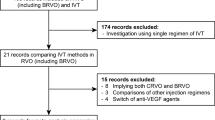Zusammenfassung
In einer prospektiven, randomisierten, plazebokontrollierten Studie über einen Zeitraum von 1 Monat verglichen wir den Effekt einer Hämodilution gegenüber einer intravenösen Gabe von Ringerlösung bei Patienten mit Venenastverschlüssen.
Die Studiengruppe mit 13 und die Kontrollgruppe mit 12 Patienten unterschieden sich hinsichtlich Alter, Geschlecht, Erkrankungsdauer, Laborwerten, Visus und Gesichtsfeld nicht. In beiden Gruppen zählten 6 der Venenverschlüsse zur nichtischämischen, die restlichen zur ischämischen Form.
Die Studiengruppe erhielt, je nach Hämatokrit, eine iso-(Hkt > 40) bzw. hypervolämische Hämodilution mit 10% Hydroxyäthylstärke 200/0,5 über 8 Tage, die Kontrollgruppe Infusionen mit 500 ml Ringerlösung.
In beiden Gruppen wurde eine signifikante Reduktion des Hämatokrits erreicht. Bei 2 Patienten der Studiengruppe verbesserte sich der Visus um 2 oder mehr Optotypenreihen, bei 6 Patienten trat eine Verschlechterung ein. In der Kontrollgruppe wurde bei 4 Patienten eine Verbesserung und bei 3 eine Verschlechterung erzielt. Die Ergebnisse der Gesichtsfelduntersuchung, des Kontrastsehens und der oszillatorischen Potentiale wurden in keiner der beiden Gruppen signifikant beeinflußt.
Summary
In a prospective, randomized, placebo-controlled stuy with a follow-up of one month we compared the effect of hemodilution to i.v. application of Ringer-solution in patients with branch retinal vein occlusion (BRVO).
The study group received according to hematocrit an iso-(Hct > 40) or hypervolemic hemodilution with 10% hydroxyethyl starch 200/05 for 8 days. The control group received 500 ml Ringer-solution for the same period.
25 patients were randomized in two groups, which did not differ in age, sex, duration of disease, laboratory data, visual acuity, visual fields and electrophysiological investigations. In both groups 6 BRVO were non-ischemic, the rest ischemic.
After 8 days the hematocrit was significantly reduced in both groups. After one months visual acuity improved in 2 patients of the study group by three or more lines. In 6 patients visual acuity got worse. In the control group 4 patients improved and 3 deteriorated. The visual fields, the contrast sensitivity and oscillatory potentials were not significantly influenced in both groups.
Similar content being viewed by others
Literatur
Bresnick GH, Korth K, Groo A, Palta M (1984) Electroretinographic oscillatory potentials predict progression of diabetic retinopathy. Arch Ophthalmol 102: 1307–1311
Dodson PM, Westwick J, Marks G, Kakkar VV, Galton DJ (1983) β-Thromboglobulin and platelet factor 4 levels in retinal vein occlusion. Br J Ophthalmol 67: 143–146
Gallasch G (1984) Ergebnisse und daraus ableitbare Indikationen für isovolämische Hämodilution bei arteriellen und venösen Gefäßverschlüssen der Retina. Fortschr Ophthalmol 81: 349–352
Ernst E, Matrai A, Kollar L (1987) Hämodilution bei der peripheren arteriellen Verschlußkrankheit: eine plazebokontrollierte Doppelblindstudie. Lancet 548: 1449–1451
Grotta JC (1989) Hypervolemic hemodilution treatment of acute stroke: results of a randomized multicenter trial using pentastarch. Stroke 20: 317–323
Hansen LL, Danisevskis P, Arntz H-R, Hövener G, Wiederholt M (1985) A randomised prospective study on treatment of central vein occlusion by isovolaemic haemodilution and photocoagulation. Br J Ophthalmol 69: 108–116
Hansen LL, Wiek J, Arntz R (1988) Randomisierte Studie zur Wirkung der isovolämischen Hämodilution bei retinalen Venenastverschlüssen. Fortschr Ophthalmol 85: 514–516
Hansen LL, Wiek J, Danisevskis M, Schrader W (1991) Isovolämische Hämodilution bei nichtarteriitischer anteriorer Optikusneuropathie. Fortschr Ophthalmol 88: 487–489
Kiesewetter H, Erlenwein S, Jung F, Wenzel E, Vogel W, Dyckmans J, et al (1988) Isovolämische Hämodilution bei Patienten mit koronarer Herzkrankheit. Klin Wochenschr 66: 8–14
Koscielny J, Kiesewetter H, Jung F, Haaß A (1991) Hämodilution, Springer, Berlin Heidelberg New York, pp 107–121
Peduzzi M, Debbia M, Guerrieri F, Bolzani R (1986) Abnormal blood rheology in retinal vein occlusion, a preliminary report. Graefe’s Arch Clin Exp Ophthalmol 224: 83–85
Schloßhart H (1978) Beobachtungen und Erkenntnisse bei der Fotodokumentation mit Colfarit behandelter Netzhautthrombose. Klin Monatsbl Augenheilkd 172: 895–901
Schmid-Schönbein H, Goslinga H (1992) Review article: The present state of hemodilution therapies: potentials and limits of the most potent tool of clinical hemorheology. Clinical Hemorheology 12: 883–901
Sedney SC (1976) Photocoagulation in central retinal vein occlusion. Doc Ophthalmol 40: 1–241
Trope GE, Lowe GDO, McArdle BM, Douglas JT, Forbes CD, Prentice CM, Foulds WS (1983) Abnormal blood viscosity and haemostasis in long-standing retinal vein occlusion. Br J Ophthalmol 67: 137–142
Vannas S, Raitta C (1966) Antikoagulant treatment of retinal venous occlusion. Am J Ophthalmol 62: 874–884
Wiederholt M, Leonhard H, Schmid-Schönbein H, Hager H (1980) Die Behandlung von Zentralvenen Verschlüssen mit isovolämischer Hämodilution. Klin Monatsbl Augenheilkd 177: 157–164
Wiek J, Schade M, Wiederholt M, Arntz HR, Hansen LL (1990) Haemorheological changes in patients with retinal vein occlusion after isovolaemic haemodilution. Br J Ophthalmol 74: 665–669
Wilhelm J, Jung F, Kiesewetter H, Recktenwald C (1986) On hemodilution therapy for patients with sudden loss of hearing. Klin Wochenschr 64: 1058–1062
Wolf S, Arend O, Bertram B, Schulte K, Kaufhold F, Teping C, Reim M (1991) Hämodilution bei Patienten mit Zentralvenenthrombosen der Retina. Fortschr Ophthalmol 88: 35–43
Wolf S, Schulte-Strake U, Bertram B, Schulte K, Arend O, Reim M (1993) Hämodilutionstherapie bei Patienten mit akuter vorderer ischämischer Optikusneuropathie. Ophthalmologe 90: 21–26
Wolf S, Arend O, Bertram B, Remky A, Schulte K, Kenneth JW, Reim M (1994) Hemodilution therapy in central retinal vein occlusion. One-year results of a prospective randomized study. Graefe’s Arch Clin Exp Ophthalmol 232: 33–39
Author information
Authors and Affiliations
Rights and permissions
About this article
Cite this article
Haas, A., Sochor, G., Ebner, C. et al. Hämodilutionstherapie bei retinalen Venenastverschlüssen: Eine plazebokontrollierte prospektive Studie. Spektrum Augeheilkd 9, 137–140 (1995). https://doi.org/10.1007/BF03163778
Issue Date:
DOI: https://doi.org/10.1007/BF03163778




